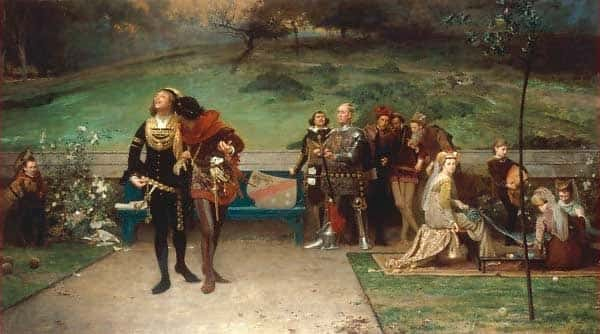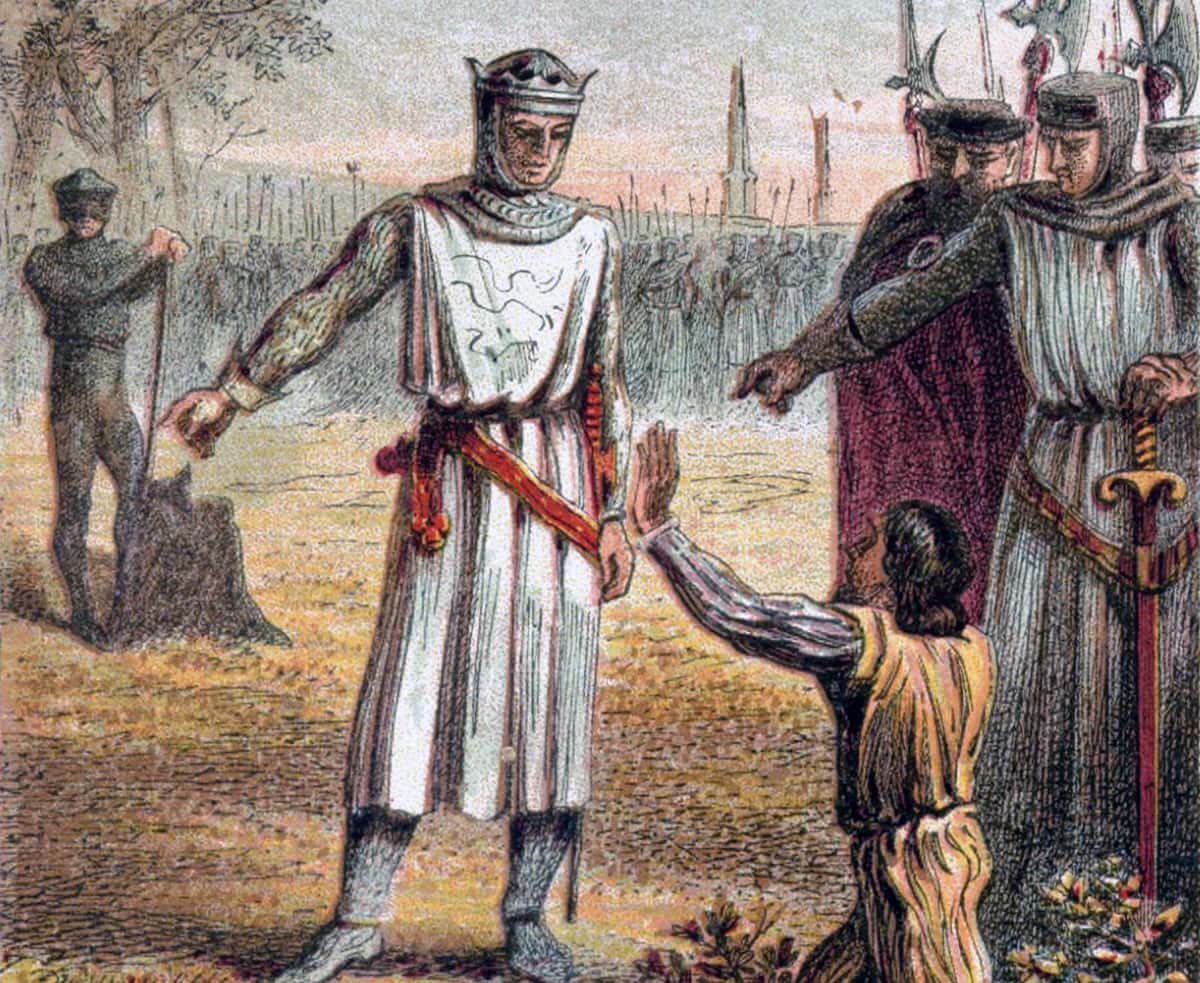Isabella, the “She-Wolf” of France and the future Queen of England, was born between May and November 1295 to Philip IV, King of France and Joan I of Navarre. When she was approximately three years old, she became engaged to the future King Edward II of England, and they were eventually married in 1308. Known for her beauty, intelligence, and diplomacy, she was most famous for her role in having her own husband dethroned. Below are 44 facts about the notorious medieval queen.
42. I Bury Your Heart with Me
Isabella lived to the ripe old age of 62 or 63, and was buried in her wedding dress at the Franciscan church at Newgate. As per her wishes, she also had the heart of her estranged husband Edward II, which had been preserved in a casket, buried with her. But, as you're soon to learn, their relationship wasn't exactly the best, making that last fact more than a little ironic.

41. Only Survivor
Isabella was the third daughter of King Philip and Queen Joan, but she was the only one of their three female children to live past five years old. Her eldest sister Marguerite died at age four or six, a year before she was born, and her second sister Blanche died in the same year she was born.
On the bright side, Isabella’s three older brothers all survived to adulthood and went on to become Kings of France.
40. One or the Other
Despite being the Navarrese heir, it was imperative that Isabella’s mother Joan be well-married to secure her kingdom. She was initially engaged to Edward I’s son Henry, but he died. After that, her cousin who was the King of France arranged for her to marry either his son Louis or Philip as part of the Treaty of Orleans. Since Louis also died young, Philip won by default.
39. Philip the Unfair
One of King Philip’s nicknames was Philip the Fair, but his treatment of the Knights Templar and the Jews in France was definitely not fair. The king borrowed money from both groups and then banished the Jews on threat of death and had the Templars executed on charges of heresy and sodomy. His other nickname, “The Iron King,” definitely seems like a better fit.
38. Motherless Girl
Isabella’s mother Joan died when Isabella was just ten years old. The most likely cause of death was complications from childbirth, but there are some historians who believe that it was Philip who was responsible for her death.
37. Ending a War
The match between Isabella and Edward II was a strategic one, orchestrated to put an end to a minor war with England for control of the duchy of Gascon which was technically a dispute between England and Scotland. In 1298, Philip put an end to the first front of the war by marrying his sister Marguerite to the Widower Edward I, but war broke out again in 1300. The hope was that by marrying Edward and Isabella, their children would be half French and they’d keep the peace.
36. Second Thoughts
Edward I apparently regretted agreeing to the match between his son and Isabella. He made numerous attempts to break it off but died before he could do so, and the marriage went ahead anyway.
35. Sealing the Peace
The Treaty of Northampton was one of Isabella’s most important achievements while acting as regent for her son, but it was also her downfall. Isabella knew that the war with Scotland was expensive and wanted to end it diplomatically. As part of the treaty, she agreed to marry her daughter Joan to David Bruce, the heir to the Scottish throne, and that Edward III would give Scotland their sovereignty.
The English nobles were none too happy about this treaty, and as soon as Edward III became king for real, he overturned the deal, leading to the Second War of Scottish Independence.
 Wikipedia
Wikipedia
34. Must Love Books
Isabella loved books and reading and owned over 30 books at the time of her death. To the modern book lover that might not seem like a lot, but in Isabella’s time, that was a sizeable collection. Among her books were a family history, an encyclopedia, a bible, and some other religious texts, and several romances. Even a queen could dream!
33. The King’s Favorite
The marriage between Edward and Isabella never stood a chance, because Edward was already in love with someone else. Edward met Piers Gaveston when they were just teenagers, and it was supposedly love at first sight. Edward’s father had some idea of what was going on and banished Gaveston from England. His banishment was short-lived, and the moment Edward I died, the new king sent for his lover, making him the Earl of Cornwall and marrying him to his niece.
32. Twisted Priorities
Edward had no regard for appearances, and he blatantly ignored Isabella to spend time with Gaveston. He even gave Gaveston some of the jewels from his wife’s dowry and sat with him instead of his wife at their wedding.
31. Telling Daddy
Isabella may have been almost half her husband’s age but that didn’t mean she was content to sit by and watch him parade around with another man while slighting her. Enough was enough and she wrote to her father basically complaining that Edward wasn’t performing his husbandly duties. Philip intervened, and the king was forced to temporarily exile his bestie/lover once again.
30. Anger Among the Barons
Despite his totally inappropriate behavior where Gaveston was concerned, Isabella tolerated the relationship for years and remained a loyal and supportive wife.
Unfortunately for Gaveston, the anti-Gaveston camp of the King’s barons finally had enough of him and had him seized and executed. Needless to say, Isabella didn’t shed any tears over this one.
29. With or Without You
Thomas, the second Earl of Lancaster was the king’s cousin. Lancaster hated Gaveston, who had publicly ridiculed him by calling him the Fiddler. Lancaster knew that Isabella also disliked Gaveston, and wrote her a letter in 1311 telling her that he planned to get rid of him with or without her assistance. Lancaster followed through on his vow, and Gaveston was beheaded in 1312.
28. Royal Children
Isabella managed a feat that was pretty incredible for the time—she gave birth to four healthy children—two boys and two girls. The eldest was Edward III, future King of England, and grandfather to Richard II and Henry IV. Her other son John became Earl of Cornwall, and her two daughters Eleanor and Joan became Duchess of Guelders and Queen of Scotland, respectively.
27. A Fictional Romance
In the popular film Braveheart, Isabella is depicted as an adult woman who has a passionate affair with William Wallace and then tells Edward that she’s carrying Wallace’s baby.
Considering that Isabella would only have been two years old at the time the film took place, that’s a pretty big poetic license.
 Pixabay
Pixabay
26. A New Rival
After Gaveston’s execution, Isabella and Edward seemed to be getting along well enough for a few years, but then along came Hugh Despenser the Younger, who caught Edward’s eye. In 1318 he was appointed to be the royal chamberlain, and he became a close advisor to the king. Like Gaveston before him, Despenser was given multiple honors and titles by Edward, and was widely believed to be his lover.
25. Under His Nose
While Edward II was embroiled in a political struggle with his Barons, the Scots were busy raiding the north of England. It was only when Berwick, a Scottish stronghold that had been in English hands for 22 years, was recaptured that he suddenly took notice of what they were doing and reacted. It sure took him long enough!
24. I Capture the Queen
Around this time, Isabella was hanging out in York at a residence belonging to the Archbishop of York. All the while, the Scots were headed toward her with the rumored aim of kidnapping her. Luckily for her, the plan was thwarted, and she was convinced to flee to Nottingham for safety.
23. A Spy in their Midst
The Scots knowledge of Isabella’s location could only mean one thing—there was a spy or a traitor in their midst. At first, Edward thought the culprit was his cousin Lancaster, but the real perpetrator was an English knight called Edmund Darel. When Darel was captured and interrogated, he spilled the beans, but even then, nobody really thought he was telling the truth. Surprise!
22. End Game
Robert the Bruce knew that the best way to get Edward away from Berwick would be to capture his wife. It would not only have caused Edward tremendous shame, but she would have been a means of ending the Scottish-English conflict over independence.
Beginning with Edward I, the English had claimed to rule Scotland outright, and Robert the Bruce wanted to be recognized outside of Scotland as its true king. He figured that he could use Isabella as a bargaining chip by trading her release for Scottish independence. It would have been a brilliant plan, had it worked.
21. She’s the Worst
Considering what a tough gal she was in life, Isabella has been pretty negatively portrayed in modern history books. One of the first mentions of her was in a book about the Queens of England written by a pair of Victorian sisters in 1894. One of the authors, Agnes Strickland, totally disapproved of Isabella, and stated that she was “one of the worst women that ever occupied the throne of England.”
This negative opinion was formed primarily because Isabella was the exact opposite of the ideal Victorian woman. Her estrangement from Edward and affair with Roger Mortimer didn’t exactly paint her as pious, and I’m pretty sure submissive wasn’t in her vocabulary.
20. Public Sympathy
Throughout her marriage to Edward, Isabella played peacemaker with Edward and his barons, and she was popular and respected by the people. She was also a bit of a sympathetic figure with the political elite. They were well aware of Edward’s preferential treatment of his male favorites, and largely felt that she’d been mistreated by him.
19. The Other Isabella
Isabella de Beaumont and her brother Henry were important figures in the court of King Edward II, and Isabella became a close friend to her queenly namesake. When Queen Isabella came over from France, Beaumont became her lady-in-waiting and they kept in touch via correspondence whenever they were apart. The queen also sent Isabella a number of gifts, including brie cheese from France. Yum!
18. Placing Blame
Edward’s failed invasion of Scotland caused a huge rift between Edward and Isabella. She blamed his allies, the Despensers, and Edward blamed Isabella de Beaumont’s idiot brother Louis de Beaumont, whose promised “stone wall” against a Scottish invasion didn’t quite hold up as promised.
17. The Queen’s Lover
With the way things were going between Isabella and Edward, it’s not surprising that she ended up falling into the arms of Roger Mortimer—an English knight who opposed the Despensers and King Edward II.
Exactly when he and Isabella hooked up is unknown. It might have been while they were both in France, or it might have been while he was still in England, before his imprisonment in the Tower of London. Whenever it was, they became quite the power couple!
16. Accumulating Land
When the Queen mother Margaret of France died in 1318, Isabella inherited some of her estates and kept going from there. By 1320, she had several estates in North Wales, held the County of Ponthieu, and had lands and castles in more than one dozen English counties. Not a bad total at all!
15. She’ll Come Back if She Wants To
Isabella was initially sent to France to negotiate peace with her brother King Charles IV after he seized all of Edward’s French possessions, but that wasn’t all she did while she was there.
By this point, many of his nobles were fed up with Edward, and she was none too thrilled with him either. She used her time in France to amass an army to oppose Edward, completely enraging him. He tried to demand that she return to England, but this is where having a king for a brother comes in handy. He told Edward that Isabella had arrived in France of her own free will, and she’d only return to England if and when she felt like it, because he had no intention of kicking her out.
14. A Price on Her Head
In the summer of 1326, Isabella and her lover Mortimer left France, but instead of heading back to England, they met up with William I, Count of Hainaut in Holland and secured some ships in exchange for arranging a marriage between his daughter and her son Edward.
A few months later, in the fall of 1326, the pair returned to Suffolk with their mercenary army. Her husband Edward was naturally ticked off and allegedly offered a reward for their deaths, but Isabella responded in kind by offering twice as much money for the death of Hugh Despenser the younger.
 Public Domain Pictures
Public Domain Pictures
13. Not Much of a Fight
The battle against Edward II turned out not to be much of a battle. Edward’s allies immediately deserted him without a fight, the Despensers got killed in the invasion, and Edward was captured and forced to abdicate in favor of his son.
12. Deliberate Provocation
Before their separation, Edward and Isabella were a pretty crafty pair, and her slight at the Leeds Castle was engineered to give Edward an excuse to start a war. Edward encouraged Isabella to stop at Leeds, knowing she’d likely be refused and that he could rile up his nobles to go to battle against Badlesmere and the Contrariants.
11. You’d Better Watch Her
Hugh Despenser was quite the bug in Edward’s ear when it came to making sure that Isabella had as little power as possible. He made Edward paranoid about the threat of a French invasion and helpfully pointed out that Isabella had strong ties to France.
Edward took the bait and seized his wife’s lands, while Despenser installed his wife as Isabella’s housekeeper to spy on her and censor her correspondence. Edward even took her kids away from her and gave them into the care of the Despensers. No wonder she snapped!
10. Scandalous Behavior
King Charles IV was a fairly supportive brother, but Isabella’s affair with Roger Mortimer created a lot of headaches for him. As rumors of their affair spread throughout Europe, Charles was forced to hear complaints about her scandalous behavior from the Pope. This was simply too much for Charles, and he kicked her out of his court.
9. Dubious Position
Edward’s deposition from the throne did not guarantee smooth sailing for Isabella. There was still a chance that Edward’s supporters retaliating and trying to take back his throne, and many lawyers at the time didn’t think she had solid legal grounds for deposing him in the first place.
8. Was She Involved?
The death of Edward II is a huge mystery, as is Isabella’s potential role in it. According to legend, she and Mortimer arranged for his death, but did it in such a way that it wouldn’t fall back on them.
In reality, nobody knows who ordered Edward’s death, and according to some historians, he may not have been murdered at all, but hid in Europe for 20 years until his natural death.
7. I Claim the Throne!
Isabella’s brother King Charles IV died without a direct heir to his throne, so her son King Edward III decided to name himself the King of France through his mother’s line. This worked just fine in England, where the law stated that male descendants have a right to the throne, but not in France, where only an heir from the paternal side could inherit. This struggle over succession led to the Hundred Years’ War in 1337.
6. Getting Greedy
It turned out that Isabella was every bit as ruthless as her father had been, and support for her and Mortimer quickly dwindled when it became apparent that they were no better than Edward and the Despensers.
They were seizing land from their enemies left, right, and center, and instead of redistributing them, kept the land and wealth for themselves. Between Edward II’s mysterious death and the unpopular Treaty of Northampton, the nobility and even Isabella’s son turned on the pair, and Edward III had Mortimer executed.
5. Showing Leniency
While Mortimer was executed for treason, Edward III he showed his mother some leniency and painted her as the innocent victim at his trial. He kept her well but powerless until her death.
4. Big Mistake
Making an enemy of Isabella was never a good idea, as Margaret Badlesmere learned after denying her entry to Leeds Castle. She had no good reason, other than just disliking Isabella for refusing to use her influence to get one of her friends a position in the Exchequer Office.
In an act of petty retaliation, she not only refused to let her in, but had her archers shoot at her when she tried to enter by force. Margaret ended up being arrested and was the first woman to be imprisoned in the Tower of London for her actions.
 shutterstock
shutterstock
3. Tall, Blonde and Handsome
On the surface, Edward II was a total catch. He was tall, blonde, good-looking, and athletic—everything a medieval girl could want in a husband.
Looks were about all he had going for him, however, and he was said to be cowardly, frivolous, lacking any financial restraint, and was known to drink excessively and gamble to boot. There were also persistent rumors about his sexuality, with many suggesting that he preferred—rumors that his multiple male "favorites" seem to hint may have been true.
2. Merging Two Figures
The first description of Isabella as a “She-Wolf” was by the 18th-century poet Thomas Gray in his poem “The Bard.” His poem combined Christopher Marlowe’s depiction of the French Queen with Shakespeare’s portrayal Margaret of Anjou as the she-wolf of France in his historical plays. As befitting of a wolf, he describes her as “ripping open her husband’s bowels with her unrelenting fangs.” Brutal!
1. They Murdered My Marriage!
Isabella certainly had a flair for the dramatic and while in France, she dressed in widow’s clothing and told anyone who would listen that the Despensers were responsible for destroying her marriage and that she would mourn until they were taken care of. Not terribly subtle, but effective!

Sources: 1, 2, 3, 4, 5, 6, 7, 8, 9, 10, 11, 12, 13, 14, 15, 16, 17, 18, 19, 20, 21, 22, 23














































